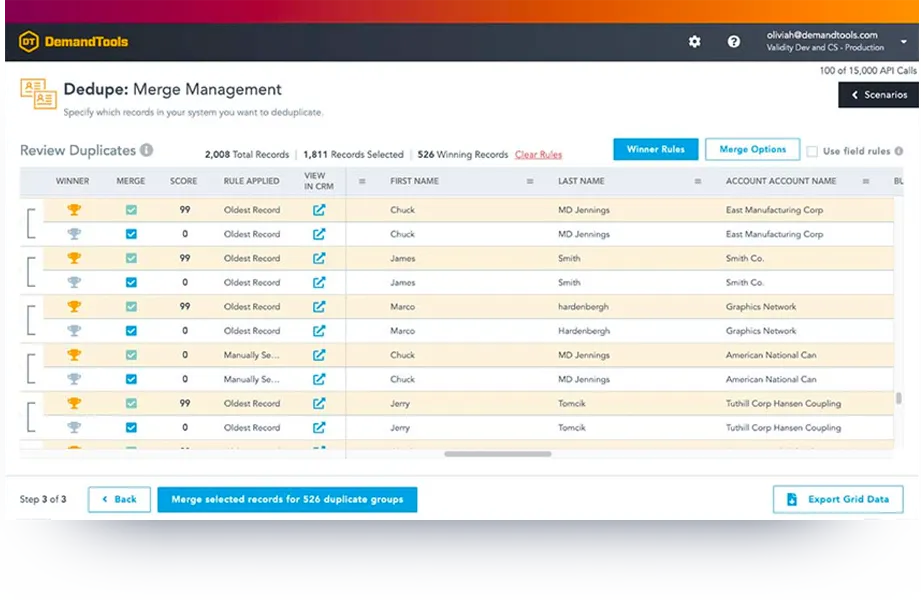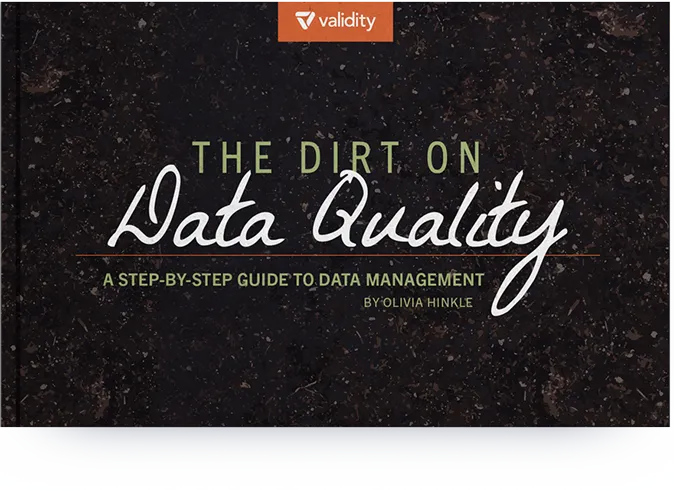Your data insights are only as strong as your data quality, which is why data cleaning should play a critical part in your business’s data routine.
Data cleaning, also known as data cleansing or data scrubbing, aims to reduce or eliminate data issues found within your datasets. It’s the process of identifying and correcting data errors, which may include incorrect, misformatted, corrupt, mislabeled, duplicate or incomplete data.
Data cleaning should always be a top priority within your organization’s data handling practices. The reality is that when dealing with relational data, the odds of data errors occurring, including duplication and mislabeled data, will continue to increase. These errors will negatively impact your business activities, from revenue to reputation.
Initiating an active and consistent data cleaning plan will help your organization maintain accurate, reliable data and useful data analysis.
73%
of businesses say that unstandardized and/or duplicate data is their marketing department’s biggest obstacle when evaluating campaign performance.
*(source: State of CRM Data Health 2022)
The 5 Steps of Cleaning Data
1. Profiling
The first step in data cleaning is understanding the current state of your data or finding where the messes exist that need to be cleaned up. Data profiling evaluates data accuracy and completeness and identifies inconsistencies, duplicates, and whether your data conforms to any standards or patterns.
The exercise of profiling forces you to question if your data is housed in the right spot, robust enough for your needs, easily analyzed or reported on, and current.
Learn more about profiling techniques and how you can profile your data today.
2. Standardization
If you want to be sure your reports are looking at a complete data set, you need to implement standardization. Standardization is the process of converting data to a common format so users can process and analyze it. It’s also a great place to start fixing what you found in profiling.
For example, a United States postal code of 33914 could appear as 33914-1234, or 339 14 with a space in the middle. This not only makes it difficult to query and report on, it throws off every other process that relies on that data. Fixing those errors and keeping formats consistent across all data, and systems, makes human or computer analysis much more feasible and accurate.
3. Deduplication
Duplicates are inevitable in any database but are especially prevalent in CRM systems where customer-facing teams are adding and changing data every day. Data deduplication refers to the removal or deletion of redundant records. It’s a process that removes extra or excessive copies of data in your database so that only the singular piece of data remains in the master data.
Redundant data can harm your business processes and strategy. In fact, we found that 48% of businesses report that duplicate data seriously impairs their ability to fully leverage their CRM system. Meanwhile, 60% of businesses cite duplicate data as the marketing department’s biggest obstacle when pulling campaign lists and 73% cite it as their biggest obstacle when evaluating campaign performance.
Learn more about deduplication techniques and how you can deduplicate your data today.

4. Verification and Enrichment
Focusing on verifying data such as email address, phone number, and physical address will help you stay in contact with your customers and prospects, making it a great investment. Next, consider verifying or enriching data points that help you create frictionless customer experiences or are key indicators in your industry.
5. Automation and Monitoring
In the best-case scenario, your company has already implemented cutting-edge prevention strategies to help reduce any problems before they even occur — but even in that case, you’re not going to completely eliminate potential data issues.
Successful monitoring of errors involves screening for these five major types of problems and automating the screening and clean up processes wherever possible:
- Missing or excess data: Empty fields, missing values, or non-relevant information.
- Incorrect data: Data that has been entered inaccurately, such as misspelled names.
- Misformatted data: Data is in the wrong field or doesn’t follow standard structures.
- Duplicate data: A single piece of information is mistakenly recorded more than once in the system.
- Unanticipated results or analysis: A resulting analysis based on data goes against common knowledge or logic.
Get step by step instructions on how to address data quality in our eBook “The Dirt on Data Quality”.

Challenges that arise when cleaning data
Data errors may appear straightforward at first glance, but sometimes they’re not what you expect. Some common challenges that can reduce clean data include:
- Unknown weak points: There are errors in your data, but you’re unsure how or where they occurred in the data process.
- Deleted data: Information that is needed to fill gaps in data cannot be found in the data warehouse.
- Multiple data sources: Many businesses collect data from a multitude of sources, which won’t follow identical structures or formats. This can increase errors and unusable data if they’re not standardized during data entry.
- “Clean” data needs to replace “dirty” data: Erroneous data that has been identified and fixed needs to be replaced in the system, instead of added.
- Consistent, costly maintenance: To ensure continuously good quality data, data must be cleaned on a regular schedule, which can be time-consuming and expensive.
What to look at when cleaning data
Earlier, we discussed the five major types of data errors to keep an eye out for as you’re cleaning data. Below we’ll cover a more expansive list of the potential mistakes that can hurt your data quality.
- Irrelevant data: This is data that isn’t important or relevant to your business and its goals. Your company should identify exactly what data is important and stop gathering unnecessary information that can cause future problems.
- Type conversion: Data types should be standardized across a dataset. If the value is numeric, then all corresponding data values should also be numeric. If not, there will be a categorical value error. Use specific field types to ensure entry of accurate data instead of free form text fields.
- Syntax errors: These errors occur when there is a coding issue that is affecting how the data is processed. Some solutions to this problem include removing white spaces, padding strings, and fixing any typos in the code.
- Standardize data: Make sure that each dataset follows the same format. For example, if the data is using “units,” then all should be in that format.
- In-record and cross-datasets errors: These errors occur when two or more values in a dataset contradict each other’s information. An example of this is if your total doesn’t accurately match the sum of your data’s values.
- Unused fields or field redundancy across objects: Data should be captured in one spot and then shared across related records. Capturing the same data point in multiple spots leads to incomplete and inconsistent data capture.
Benefits of having clean data within your organization
Data is the backbone to successful business strategy and gleaning valuable insights. But not all data is equal — that’s why data cleaning helps your organization accelerate and grow.
With clean data, your business can benefit from:
Improved decision-making
Quantity doesn’t equal quality and data is the best example of that. With clean data, your teams can make better decisions because they’re using the highest quality and most relevant information needed to do their jobs well.
Accurate data also helps to build trust within your organization. If employees aren’t worried that they’re working with incomplete — or worse inaccurate — information, they’ll be more likely to create innovative solutions and strategies to help grow your business.
Reduced costs
Efficient and effective data cleaning can cut down on the costs related to solving a disorganized or erroneous database. For example, if your data system can’t access or provide accurate payment data, your team may be on the hook for lost or incorrect payment information.
Cleaning can also help you utilize past data that will still be needed in future processes and strategies — consider it an investment in your future data.
Increased productivity
Data cleaning helps to maintain organized data which ultimately maximizes efficiency. Your collected data will be more accessible to the teams that require it when they need it most.
Especially since they won’t have to spend unnecessary time looking for or collecting data that should be easy to find in your CRM.
Positive reputation with customers
When you’re collecting customer data, it’s essential that you apply that information and engage with each customer correctly (in relation to the data). With dirty data, you may be working with invalid data, which will increase the chances of negative customer interactions.
For example, if your team reaches out to a customer with irrelevant information or unwanted communications, you’ll damage your brand’s reputation. Meanwhile, clean data will help build trust between you and your customers as improved accuracy will help you engage in a positive and consistent manner.
Competitive edge
Gathering customer data helps you to deliver a targeted message that will feel more personalized, which will create better audience engagement and loyalty to your company rather than your competitors.
82%
of businesses use their data to differentiate themselves and gain a competitive advantage.
*(source: State of CRM Data Health 2022)
Data cleaning solutions
So how do you start — or improve — your data cleaning processes?
First, determine the type of process that best fits your data needs. Manual data cleaning should function at some levels of your data handling process, but it’s not the most effective or error-preventative method in today’s age of consistently changing and growing big data.
If you house a large quantity of data, we recommend that you opt for an automated data cleaning tool that can handle all of your data. Companies invest in a data management platform that can handle CRM data securely and efficiently, without compromising accuracy.
In Validity’s DemandTools platform, we include a scheduler which gives your team the power to automate a variety of data cleaning scenarios on a a schedule or kick off multiple cleaning jobs with a click— all based on your company’s specific needs.
Dig deeper into Validity’s data cleaning solutions and see DemandTools in action.